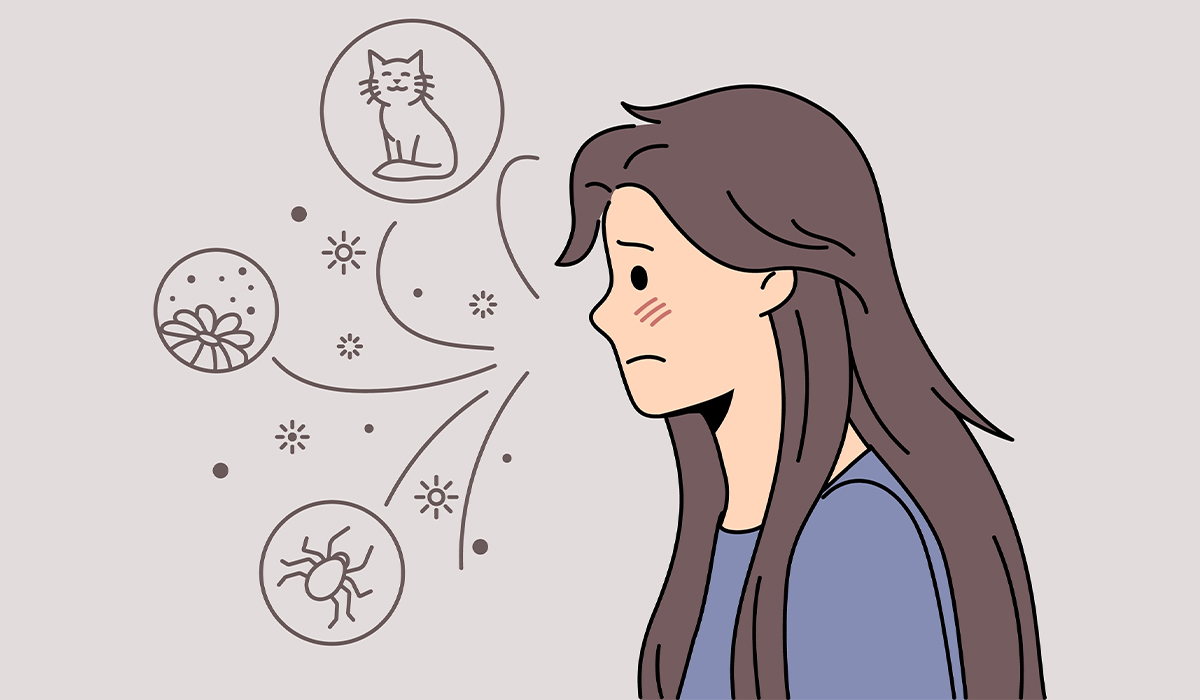There are six muscles attached to each of your eyeballs, which control the movement of your eyes. In strabismus, those muscles are not working correctly, resulting in eye misalignment.
In adults, double vision is often corrected by compensatory head positioning, such as tilting the head. In this position, double vision occurs less or does not occur. Sometimes, it is necessary to cover one eye permanently. In the case of children, eye misalignment leads to suppressing one eye’s image, which leads to the development of amblyopia (lazy eye). That’s why it’s important not to hesitate to visit an eye doctor if your child’s eyesight is incorrect.

Causes
Causes of strabismus may be various. Usually, the exact cause cannot be identified, but some crossed eyes can be linked to other conditions. The most common include:
- Visual impairment – high hyperopia or nearsightedness may result in eye misalignment. Correcting it may result in the correct positioning of the eyeballs.
- Conditions of the eye socket – inflammation or tumor of the eye socket may be the reason for the eye muscle’s incorrect functioning and incorrect positioning of the eyeballs.
- Diseases of the eyeball muscles and nerves innervating them – those muscles are responsible for the movement of the eyeballs. These diseases more often cause paralytic strabismus.
- Intrauterine infections, such as toxoplasmosis or cytomegalovirus (CMV), cause uveitis (inflammation of the middle layer of the eyeball).
- Central nervous system diseases
- Genetic factors – having a family history of strabismus raises the chances of having it.
When Strabismus Occurs In Children?
Children and infants are most often affected by strabismus in the first few months of their life. A newborn has misaligned eyes from time to time because their nervous system is not fully developed yet.
When a child is three months old, the so-called fixation is developed, meaning looking and following an object appearing in front of the eye, and the brain can already merge two independent images from the right and left eye into one. Thanks to this, eyes are parallel.
After three months old, if the child still has strabismus, they should be consulted by an ophthalmologist. Occasional squinty eyes, however, may be present in older infants, especially when looking at objects very close to the face.
The most common cause of strabismus in children is visual impairment. Still, it should be kept in mind that crossed eyes can indicate much more severe conditions, such as uveitis (developing as a result of intrauterine infection, e.g., toxoplasmosis, cytomegalovirus), disorders of the eyeball (cataract, retinal dysplasia), cancerous tumors (retinoblastoma – the most common cancer of the eyeball in children).
Therefore, every squinting child should be consulted by an ophthalmologist to exclude more serious disorders and implement treatment. Delay in treating strabismus can lead to the repression of the image from one eye and the development of amblyopia (lazy eye). Treatment of lazy eye is effective until age 7, so it is crucial to take this matter seriously.
Types
Strabismus can be divided into the following groups:
- Exotropias – in this type of crossed eyes, one eye is turned outwards
- Esotropias – this type of strabismus includes one eye turned inside, towards the nose
- Hypertropias – this term refers to crossed eyes in which one eye is pointing upwards
- Hypotropias – in this type, one eye is being turned downward
- Paralytic strabismus – when the third, fourth, or sixth cranial nerve is damaged due to injury, pressure, or poor blood supply, it can cause eye muscles to work incorrectly, leading to strabismus.
Accommodative Esotropia
Accommodative esotropia happens when an individual has uncorrected farsightedness that leads to the eyes turning inside, towards the nose. It usually affects people with farsightedness greater than +2.00 and a family history of strabismus associated with farsightedness. It typically starts around the age of 3.
Intermittent Exotropia
Intermittent exotropia is the most common type of eye misalignment. Strabismus is not constant and applies to one eye looking at the object while the other turns outwards. At first, it happens only when the eye fixates on the distant object, but over time, strabismus progresses and is also present when looking at the near objects.
Intermittent outward strabismus most often happens in small children.
Infantile Esotropia
In infantile esotropia, one or both eyes of the baby are turned inwards. Its onset is in the first six months of life, hence the name – infantile. It typically is not associated with farsightedness and occurs when a child looks far and near.
Crossed eyes may at first happen occasionally, but over time, they become constant and can’t be corrected with glasses. In most cases, the child with crossed eyes will require surgery on eye muscles that pull the eye. If left untreated, infantile esotropia leads to a lack of depth vision and not being able to merge the images from both eyes into one.
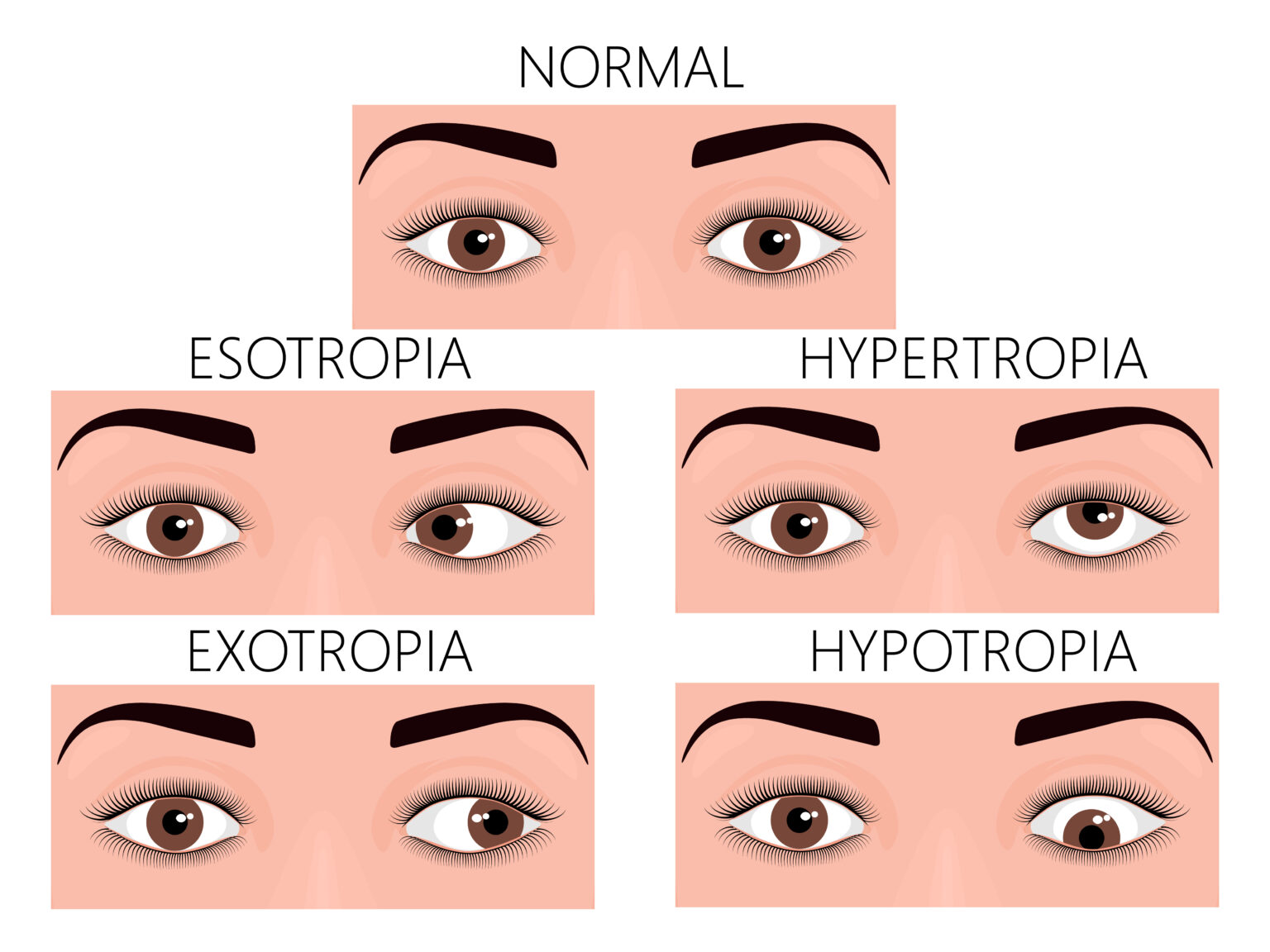
How Common Is It?
Up to 5% of the population is affected by strabismus. In the United States, 5-15 million people are affected by strabismus.
Symptoms
The primary symptom of strabismus is crossed eyes. However, some eye misalignment is not constant and can be seen only in specific situations, so it might be challenging to notice. In adults with crossed eyes, double vision or tilting the head occurs. Sometimes, people with strabismus close or cover one eye to improve their vision when looking at something.
A lazy eye develops in children with untreated strabismus, meaning the brain ignores images from one eye to avoid double vision. Symptoms such as bumping into objects, tripping, problems with sports games, or reaching for toys may be present in those children.
If strabismus is associated with muscle or nerve diseases, symptoms of those conditions can accompany it. Those symptoms include muscle weakness, paralysis, or speech difficulties.
If a child has strabismus that stays untreated, they may turn or tilt their head to correct their vision. Then, torticollis may develop, shortening the neck muscles on one side. As a result, further posture defects, headaches, back pain, and face asymmetry are developing.
In children with untreated misaligned eyes, mental problems frequently occur when they grow into teenagers. It happens due to self-image issues caused by crossed eyes.
Risk Factors
Some people might be at a higher risk of developing strabismus. The risk factors include:
- Having visual impairments such as nearsightedness or hyperopia
- Having a family history of lazy eye
- Some medical conditions, such as Down syndrome, myasthenia gravis, Graves’ disease, or cerebral palsy
- Stroke, which is the leading cause of strabismus in adults
- Head injury
- Eyeball or eye’s blood vessel injuries
- Cancer of the eyeball
- Having cataract
- Brain tumor
- Hydrocephalus (buildup of fluid in the brain that some babies are born with)
- Premature birth – children who are born prematurely are more prone to having eye misalignment
Diagnosis
The doctor diagnoses strabismus based on an eye examination and medical history. The questions you can expect when going to or taking your child to an eye doctor include:
- When was the onset of the symptoms?
- Did the eye misalignment appear suddenly or over time?
- Are the symptoms constant, or do they happen only in certain situations (when looking at objects close to the face, etc.)?
- Was symptoms present in the first three months of your baby’s life?
- Does strabismus always affect the same eye, or does it alternate between both eyes?
- Do you have a family history of strabismus?
Every child with strabismus that persists after four months of age should have an eye examination performed by an ophthalmologist. Most eye misalignments can be detected just by looking at the child. To determine the cause and advancement of the condition, the doctor may perform the following tests:
- Cover test – during that test, a paddle covers one eye, and the doctor observes the fellow eye movement. Next, an eye is uncovered, and the clinician observes the previously covered eye movements.
- Hirschberg test – This test involves lighting the baby’s eyes. Light reflections on the corneas should be located symmetrically in the center of the right and left eye pupil.
- Alignment and focus tests
- Examination of internal eye structures after dilating your or your child’s pupils
- Visual acuity test is when you read letters or symbols from a chart to determine if your vision is clear. This test is performed separately for distant and near vision for every eye.
- Refraction – Your doctor may perform a refraction to determine the lens power best for you. During the test, your eyes are checked with many corrective lenses to see which will best compensate for your refractive error (nearsightedness, farsightedness, astigmatism).
Treatment
Treatment for strabismus has a variety of options. Your doctor will choose the right one for you. Treatment options include:
- Eyeglasses or contact lenses are used if uncorrected refractive errors cause eye misalignment
- Prism lenses, which are thicker on one side and alter the light entering the eye
- Patching – if, during strabismus, a child develops a lazy eye, patching is used on the healthy eye, which forces the brain to receive the vision from the misaligned eye.
- Vision therapy – your doctor might prescribe a visual activities program to improve eye focus. Eye exercises improve eye and brain coordination and strengthen the weakened eye muscles, especially in strabismus, where the eyes are turned outwards.
- Eye muscle surgery – Sometimes, strabismus surgery is the only remedy for eye misalignment. A surgeon adjusts the length of eye muscles to align both eyes. The surgery is usually performed under general anesthesia. In some people, adjustable stitches are used where, after surgery, the eye muscle length is adjusted.
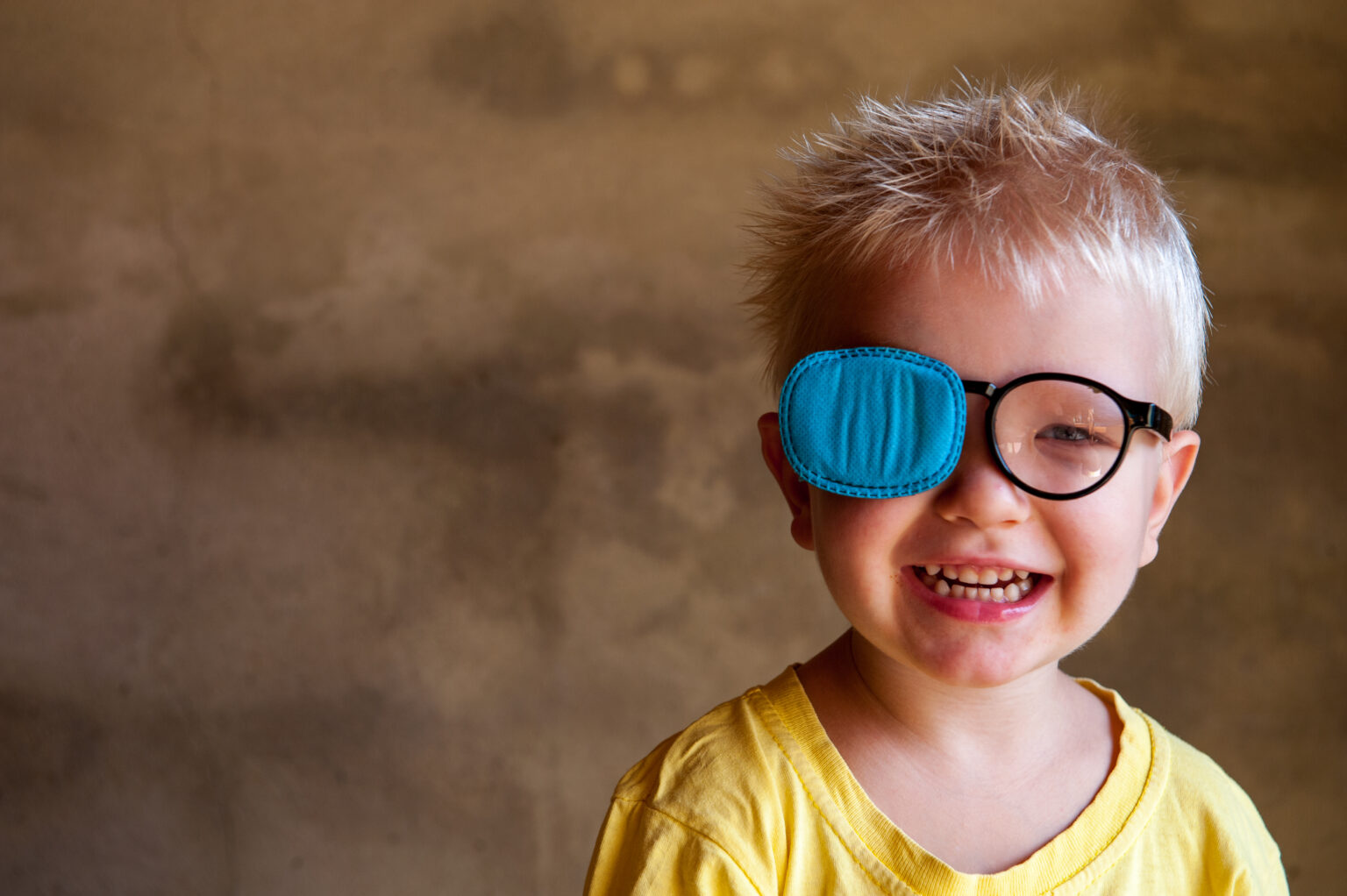
Complications
If your or your child’s strabismus is not treated correctly, it can lead to complications, such as:
- Amblyopia (lazy eye) happens when your brain receives two different images from two eyes that are not aligned. To avoid double vision, the brain ignores the image from the turned eye, which leads to poor vision and amblyopia (lazy eye).
- Eye strain
- Blurry vision
- Frequent headaches
- Worsening performance at school or work
- Poor 3D (three-dimensional) vision
- Mental problems and insecurity about the impact crossed eyes have on an individual’s appearance.
- Posture defects
Prognosis
If treatment of strabismus is started early, immediately after the abnormality becomes visible and at the youngest possible age of the child, complete recovery is possible. For this purpose, combining several treatment methods (such as glasses or contact lenses, treatment of amblyopia, and ocular muscle surgery) and good cooperation with the child’s doctor is necessary.
In children and adults, paralytic strabismus may regress due to appropriate causal treatment, but it may also remain. In such patients, surgical treatment of the eye muscles is necessary.
Prevention
Strabismus can’t be prevented. However, you can ensure it is caught in time and appropriately treated by observing your child and asking your child’s physician for testing. It’s important not to wait for treatment as untreated eye misalignment may lead to lazy eye.
Early after birth, an ophthalmological examination should be performed in children born prematurely, in whom refractive errors and strabismus are more common than in children born at term, and in children from families in which there is a family history of:
- High refractive errors
- Strabismus
- Amblyopia (lazy eye)
- Congenital eye diseases
When Should You See a Doctor?
You should see an ophthalmologist (eye doctor) if you notice your or your child’s eye turns. Note some vital information about strabismus to tell your doctor on your visit, such as if eye misalignment is constant, if it is always the same eye turning, and if it gets worse over time. Contact an eye doctor if you notice the following symptoms:
- Double vision
- If your child starts tripping or bumping into things
- Your child is over three months old and has developed strabismus
- You start covering or closing one eye to see clearly
- If you have difficulty reading
- You start tilting or turning your head
Suppose the strabismus happens suddenly and is accompanied by facial muscle weakness, weakness of the limbs, or speech difficulties. In that case, you should seek emergency medical attention since it may be the symptom of the stroke.
Sources
- Kanukollu VM, Sood G. Strabismus. 2023 Nov 13. In: StatPearls [Internet]. Treasure Island (FL): StatPearls Publishing; 2024 Jan–. PMID: 32809617. https://www.ncbi.nlm.nih.gov/books/NBK560782/
- American Optometric Association (AOA) Strabismus (crossed eyes) https://www.aoa.org/healthy-eyes/eye-and-vision-conditions/strabismus?sso=y
- American Academy of Opthalmology (AAO) Strabismus in Children (2023) https://www.aao.org/eye-health/diseases/strabismus-in-children
- American Academy of Opthalmology (AAO) Types of Strabismus (2015) https://www.aao.org/education/basic-skills/type-of-strabismus-introduction
- American Academy of Opthalmology (AAO) Infantile Esotropia (2023) https://eyewiki.aao.org/Infantile_Esotropia
- National Library of Medicine (NIH) Kirandeep Kaur; Bharat Gurnani. Intermittent Exotropia (2023) https://www.ncbi.nlm.nih.gov/books/NBK574514/
- American Academy of Opthalmology (AAO) Accommodative Esotropia (2023) https://eyewiki.aao.org/Accommodative_Esotropia
- Rowe FJ, Noonan CP. Cochrane Database Syst Rev. 2017 Mar 2;3(3):CD006499. doi: 10.1002/14651858.CD006499.pub4. Update in: Cochrane Database Syst Rev. 2023 Mar 14;3:CD006499. PMID: 28253424; PMCID: PMC6464099. https://www.ncbi.nlm.nih.gov/pmc/articles/PMC6464099/
- American Academy of Opthalmology (AAO) Hirschberg test https://www.aao.org/education/image/hirschberg-test-2
- Helveston EM. Understanding, detecting, and managing strabismus. Community Eye Health. 2010 Mar;23(72):12-4. PMID: 20523857; PMCID: PMC2873668. https://www.ncbi.nlm.nih.gov/pmc/articles/PMC2873668/

